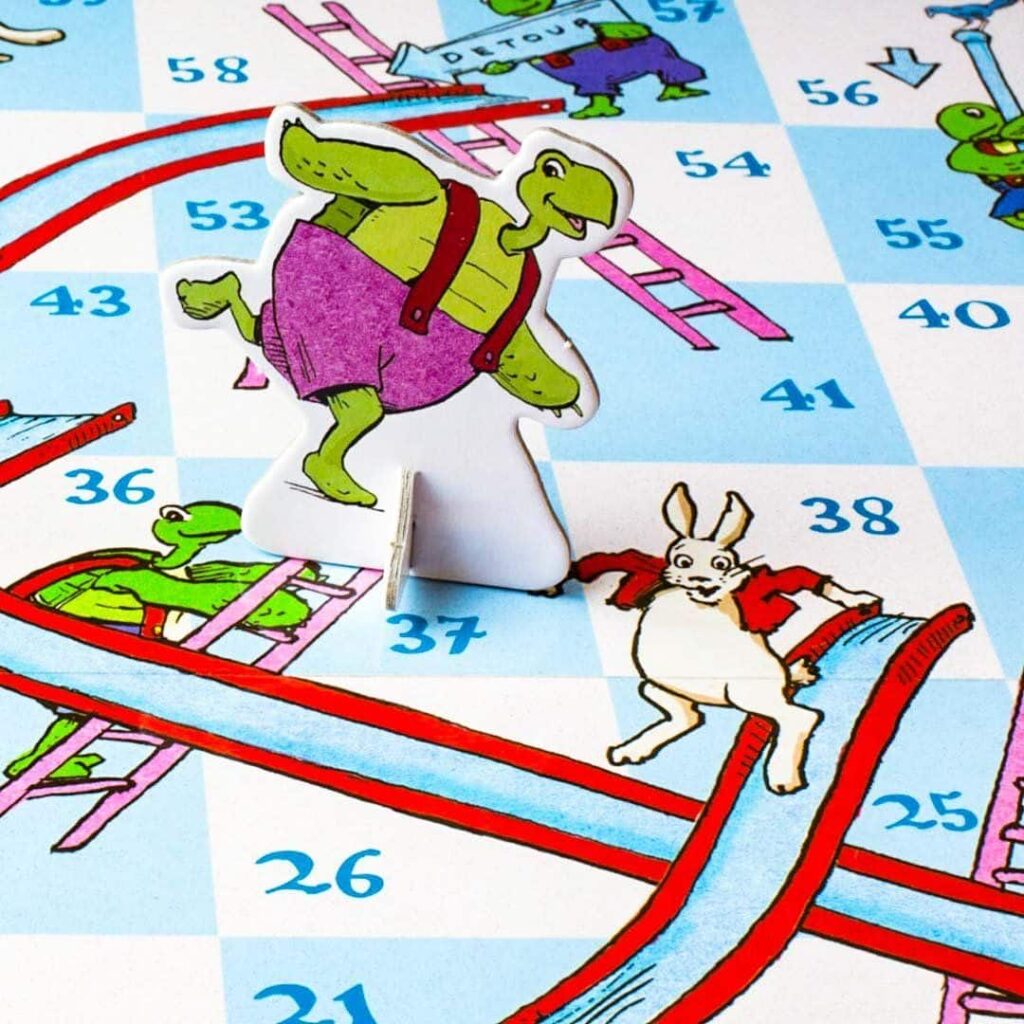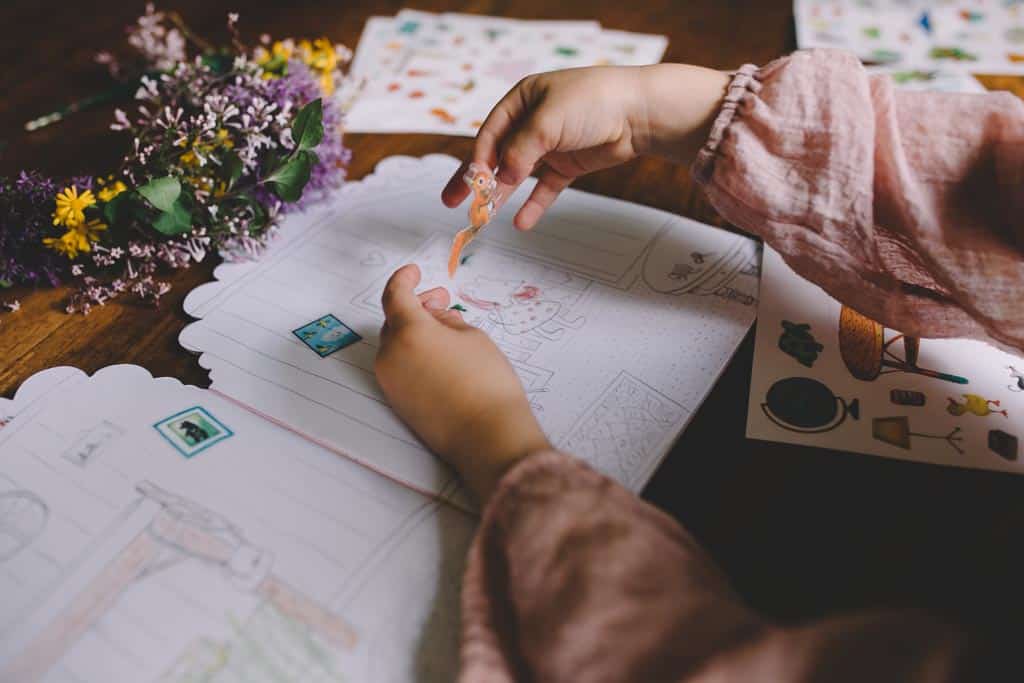I want to tell you about the benefits of snakes and ladders and how it is great for teaching children about numbers and the number system.
But people don’t like maths.
The website’s analytics data prove it. Write about creativity? Lots of engagement. Write about maths? Not so much.
I’m running a business, so why do I do it to myself? I must still have a bit of that earnest teacher streak in me. Take your medicine. It’s good for you.
If you don’t want the spoonful of cod liver oil, here’s the tl;dr:
- Play snakes and ladders
- Stick a ‘hundred square’ on your fridge door
Still here?
Great! Let’s take a deeper look at an all-time classic game.
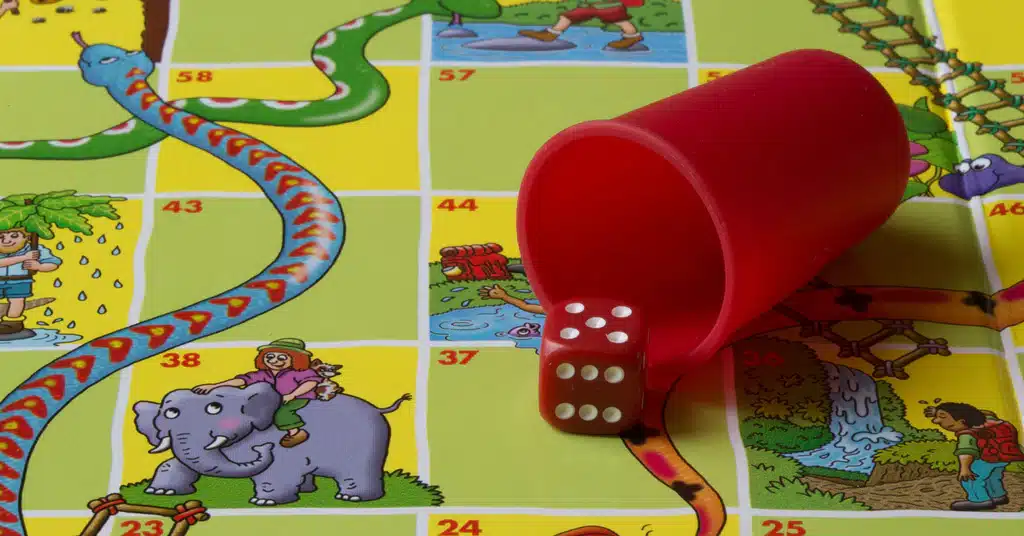
Snakes and ladders
What’s the secret? Why do children still love snakes and ladders?
There is the whole caper of it, the thrill of the ladder, the dread of the snake. And the impotent fury when you reach the end but fail to throw the right number to finish and watch your brother overtake you on the line.
But there’s more to it than just fun and family feuds.
Games with rules
Are you a good loser – or a bad one?
Can you wait your turn?
Do you cheat?
As adults, we know that how you play is who you are.
When games have rules, they also open up the possibility of developing strategy. Games for the youngest children have very little scope for this. All you can do is roll the die and hope for a ‘six’.
But in hoping for a ‘six’ you start to get the sense that there is something you could do to improve your chances. It starts with superstition – maybe blowing on the dice before you roll them would work? Or, and who hasn’t tried this one, hold the die with the ‘six’ facing up and try to drop it flat so that it doesn’t roll.
You are trying to take control of the game – because you want to win.
But before you can win, you have to learn to count.
And that’s the subject of today’s email.
Read more about games with rules.
Cardinal, ordinal, and nominal numbers
Here is one of my famous drawings.
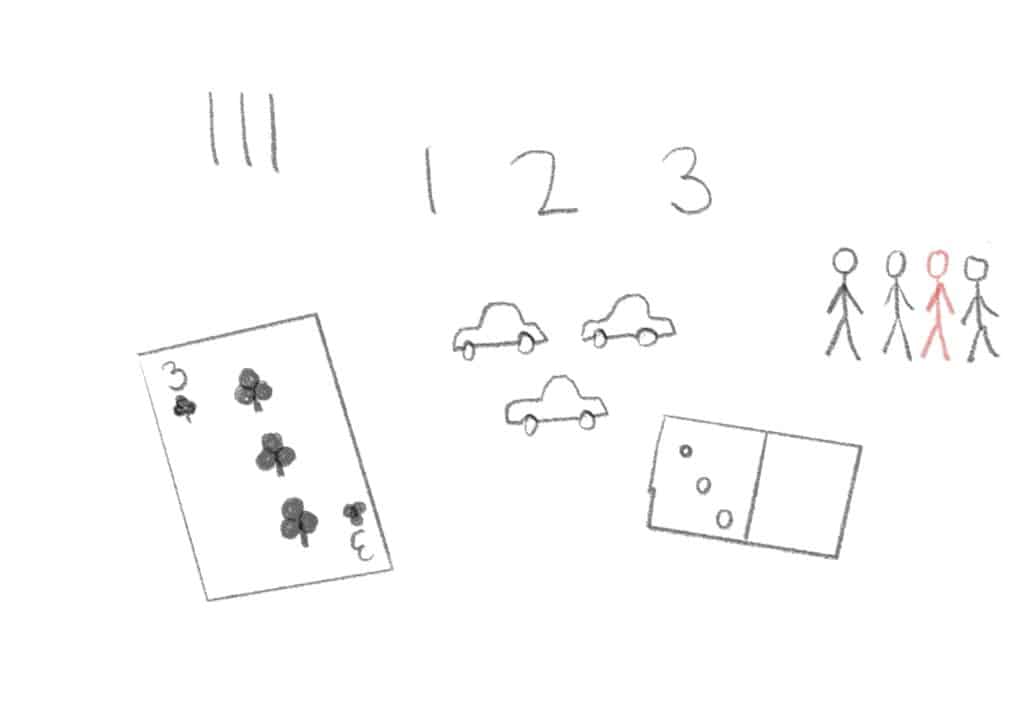
It’s about the number three.
But it’s also about first, second, third.
And, if you look at the domino and the tally chart, you see that ‘three’ is a number of items in a set.
It’s also a numeral, a symbol: 3.
All of which means that counting is harder than it seems.
These ways of looking at ‘3’ are known as aspects of number:
- Nominal numbers. The name we give numbers. I am almost at the end. I am on number 94!
- Ordinal numbers. I am in second place. You are in third!
- Cardinal numbers. The answer the question “How many…?” How many dice do you have? The final number counted is the total number in the set: 1, 2, 3, 4, 5. I have five dice!
The good news is that we can learn all this through a simple game of snakes and ladders.
Counting on: How board games teach better counting strategies
Pretend you are six years old.
Hold out your left hand. Show me all five fingers.
Now hold out your right. Show me another three.
How many fingers altogether?
Eight!
Well done! That was quick. You knew the sum. You didn’t even have to work it out.
Now let’s go further back in time. You are now four. Holding out the same eight fingers, you start from the beginning, counting all eight fingers to find the answer. This method is slow.
But at some magical point in between, you learn a different strategy. Counting on.
Five in my head and count on three: 6, 7, 8.
It’s much more efficient. It’s also how we count in board games. You find yourself on ‘5’ and roll a ‘3’. Count on three squares.
The trick with counting on – and board games – is to not count the number you started on. Otherwise you end up on ‘7’.
This concept requires a lot of reinforcement so games are the perfect vehicle for teaching it. You get lots of practice and you’re motivated to learn. Who wouldn’t enjoy finding out that they could advance one space further than they thought?
Get better at counting by counting real things
Counting in your head is good. Counting spaces on a board is better. But moving things is best of all.
That’s because counting only really makes sense when you move objects from one ‘set’ to another.
You have two sweets. I give you three more. Now you have five.
In this way, it’s impossible to make a mistake when counting on.
You don’t start from the second sweet in your hand. You only count the new ones: three, four, five!
Read this post on maths manipulatives and the concrete-representational-abstract model to learn more.
Even better, get some playground chalk and draw a big 100 square on the ground and step into the game. Nothing reinforces counting like moving your body with each number. Roll a ‘three’ and you instinctively want to take three steps. It feels wrong to count the square you started on.
One-to-One correspondence
Here are four apples. I have to count each one to find out how many there are. Sound obvious? Not to your three-year-old. Touch each one as you count out loud to master this skill – and don’t forget to do it when you play board games. Count each square as you move.
The big secret: The hundred square
This is a ‘hundred square’:
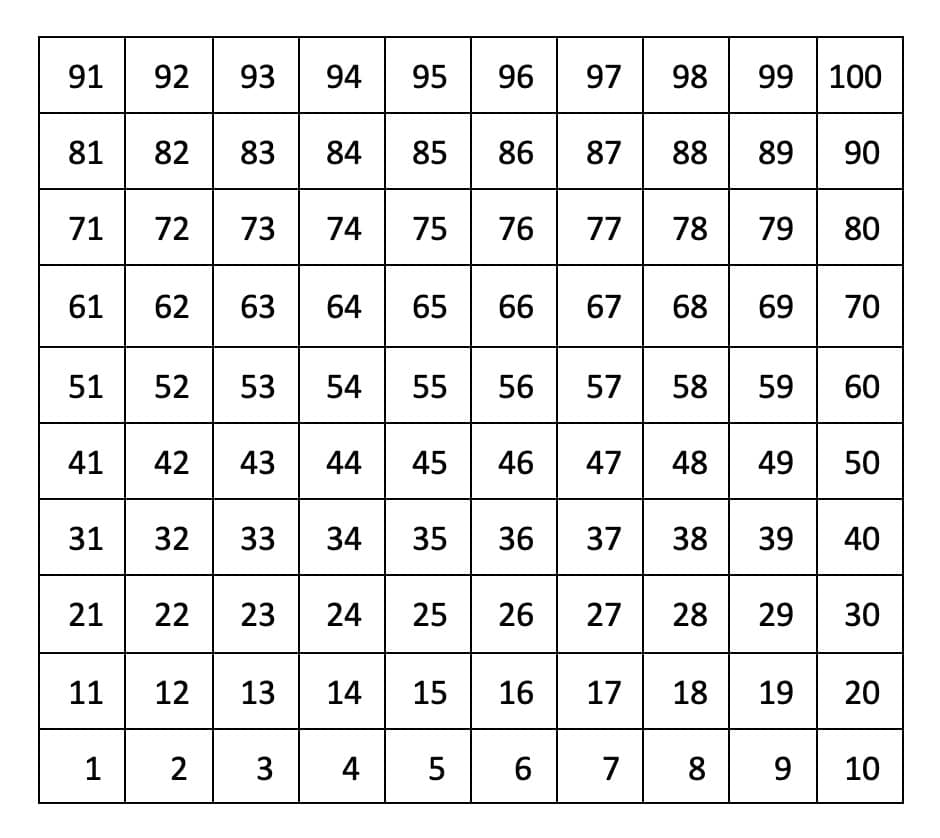
It doesn’t look like much, does it?
But it’s key to mathematical learning, because maths is all about recognising patterns.
Here’s the pattern for the five times table:

And here are the threes…
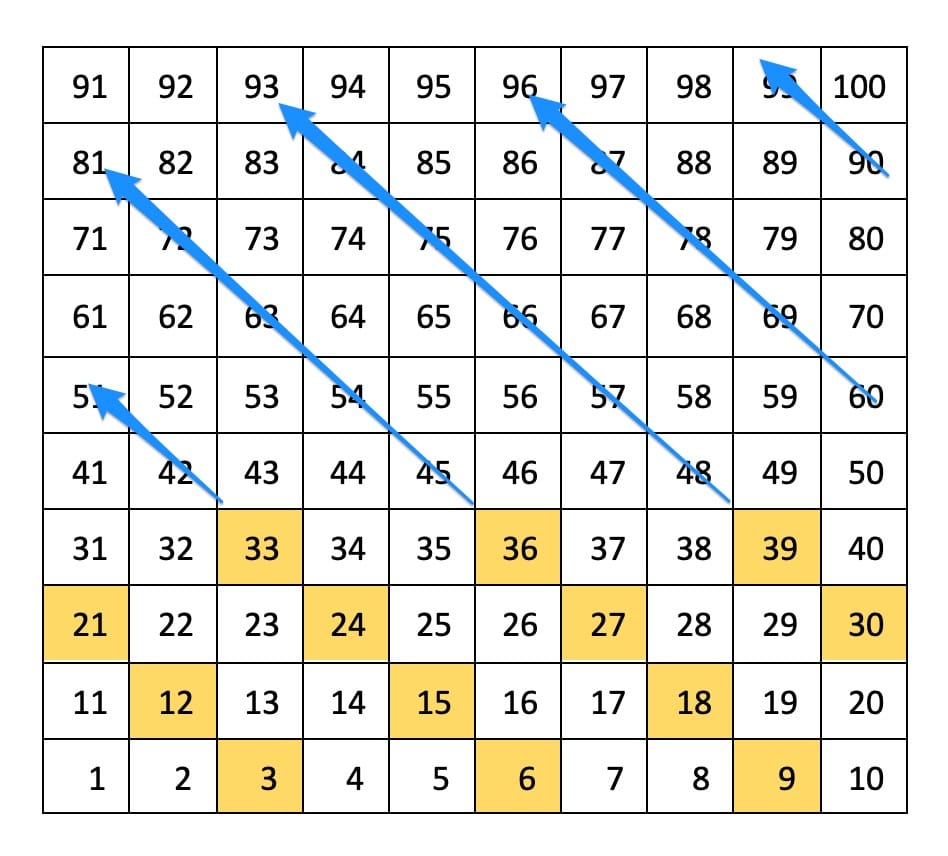
Follow the blue arrows. Is 81 in the three times table? Follow the blue arrow to find the answer. You don’t have to do any complicated maths. The pattern shows you.
In Get Set Five we talk about the ‘print-rich environment’, the idea that your child will pick up all kinds of useful things simply by seeing them often enough. Put an alphabet chart on the wall, a hundred square on the fridge and some high-frequency words on the noticeboard in your kitchen and and let the environment teach.
You don’t have to do anything.
One day your preschooler, who doesn’t yet know the numbers to 100, will notice that all the numbers going up end in the same number:
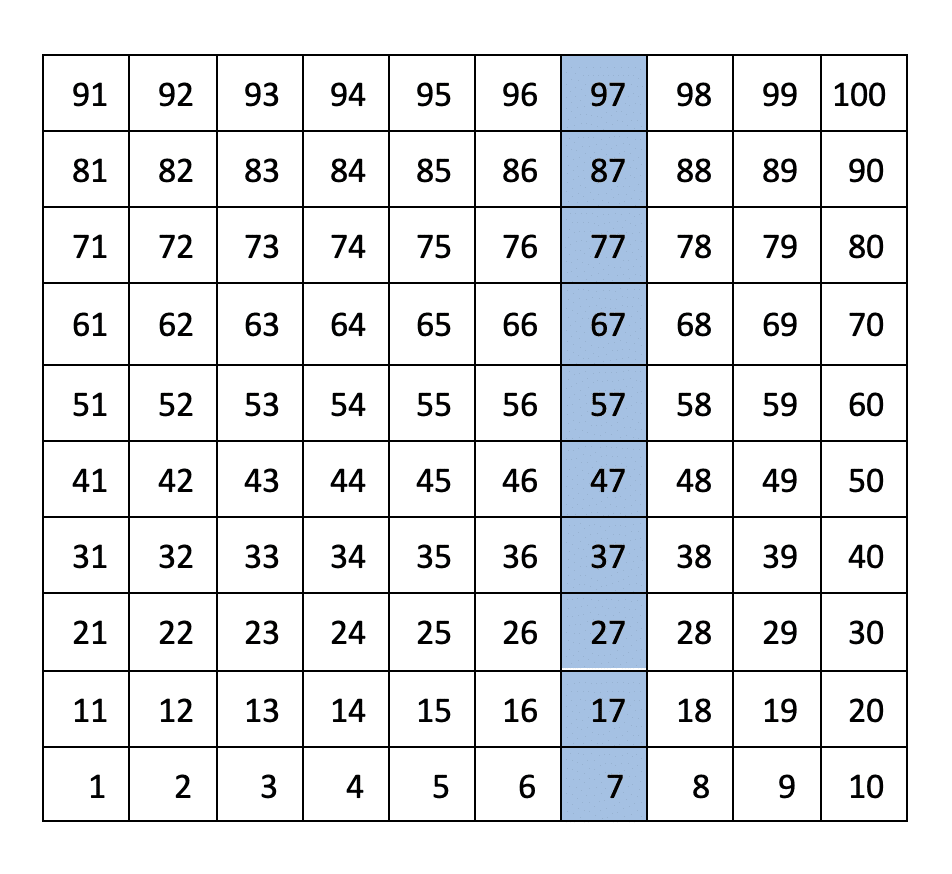
And that the numbers going across end in 1, 2, 3…
She is discovering mathematical rules. There are no workbooks. You are not sitting down to teach. The square is full of patterns and it is interesting.
Soon your child will discover her first times table:

And once she has learnt basic addition, she will notice that to find what’s one more than any number you go right one square. To find 10 more, you go up:
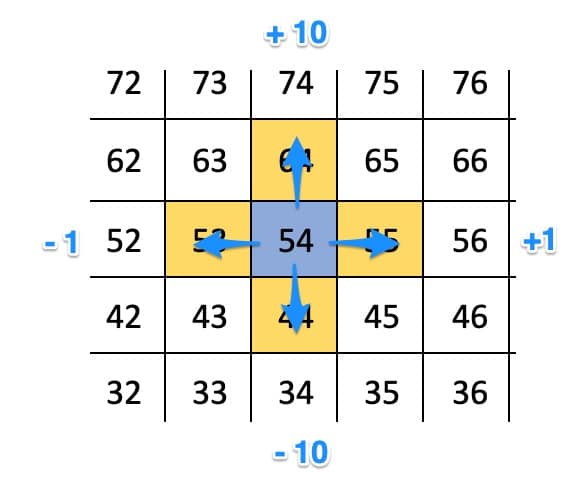
So far, so easy. What a magical tool!
Of course, you’ve spotted the flaw with the 100 square in snakes and ladders…
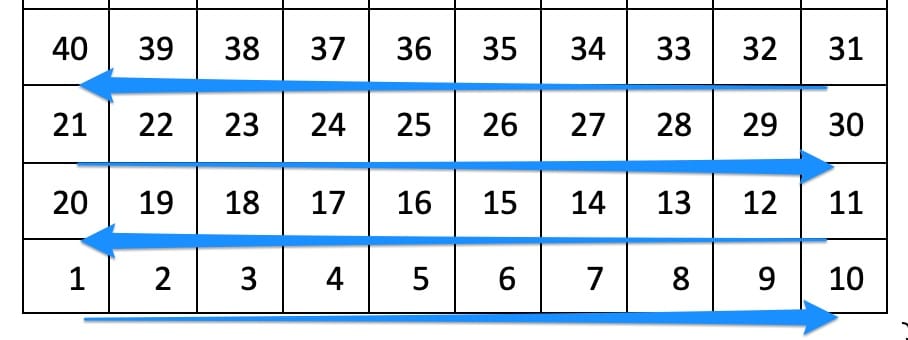
The numbers ’snake’ back on themselves, going left to right then right to left. Very confusing!
You have spent all this time teaching your child that we read left to right and now the numbers are going in the wrong direction!
But all is not lost.
Snakes and ladders still goes from 1 to 100. The next square is still one more than the previous one. We still need to count on and use one-to-one correspondence.
And the board, whichever way the numbers go, helps children get a feel for how big one hundred is compared to other values they already understand, such as their own age. Getting to 100 takes forever when you are on the first row. Getting to 10? That’s easy.
Make your own snakes and ladders board
The best way to get round the problem of the snaking numbers is to make your own board game.
- Draw or print out a 100 square.
- Decorate it.
- Find a die (or make a spinner).
- Play!
It’s a lovely way to spend an afternoon and your child will be inspired to make more games of her own.
Not just snakes and ladders
The hundred square makes snakes and ladders special but other board games share many of the benefits.
If you have an under 5 and she isn’t quite ready for numbers as high as 100, take a look at Orchard Toys, Peaceable Kingdom and eeBoo. HABA also have dozens of games. They are expensive but very well made.
There are boards without numbers, just steps, and there are simple trails only going as high as 10 or 20. There’s sure to be one out there that’s right for you.
Final word
Your child may be too young to fully participate in the game but the benefits of snakes and ladders extend far beyond a few minutes of family fun around the board.
Simply leaving her to explore the grid encourages all kinds of learning and discovery. Watch her count the squares with her finger, roll the die and move the counter. Playing the game merely is the icing on the cake.
Are you ready for school?
Do you have a preschooler? Would you like them to develop some key skills before starting school? How wonderful to go into school on that first day feeling like you belong.
Get Set Five is a year-long course full of fun and free activities to do with your child.

